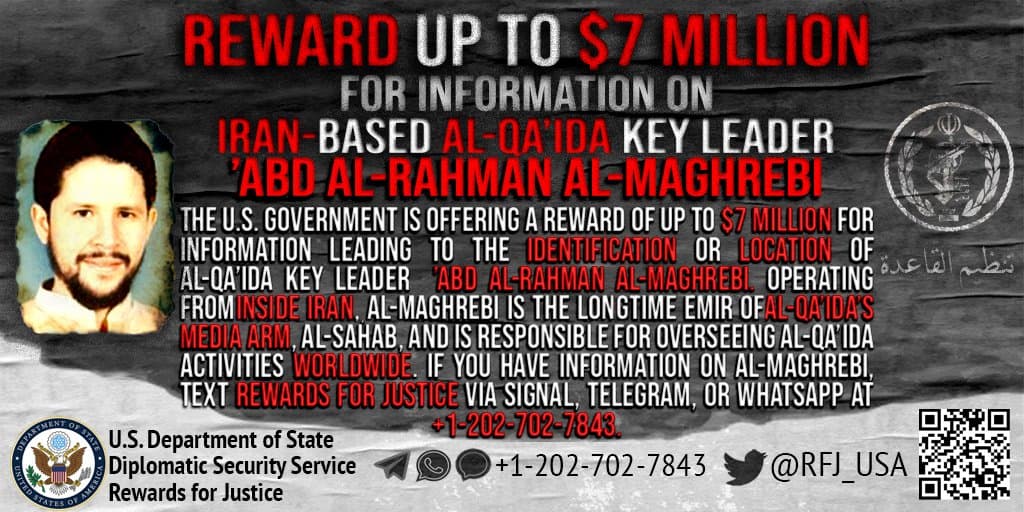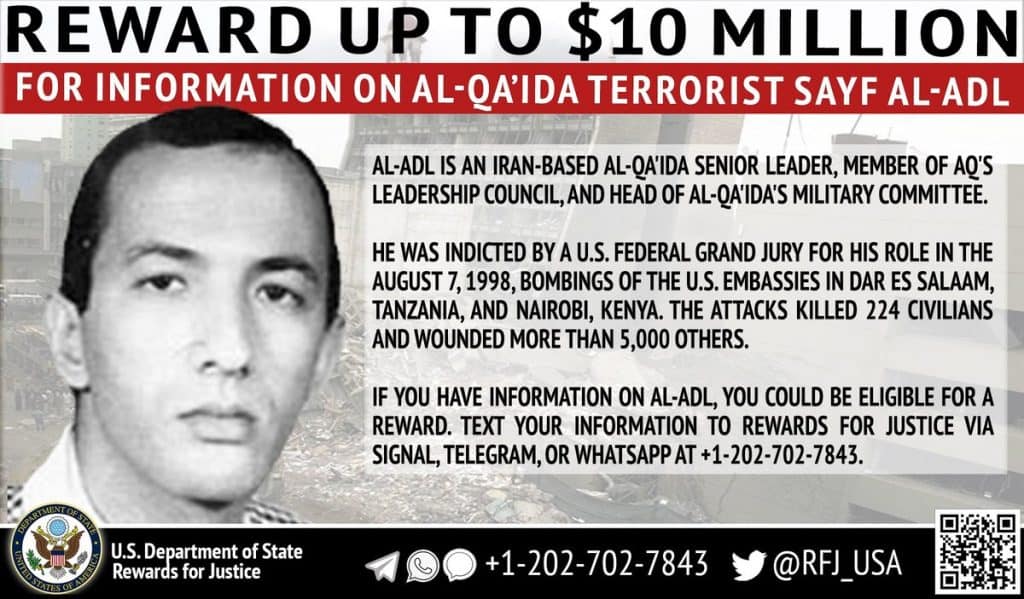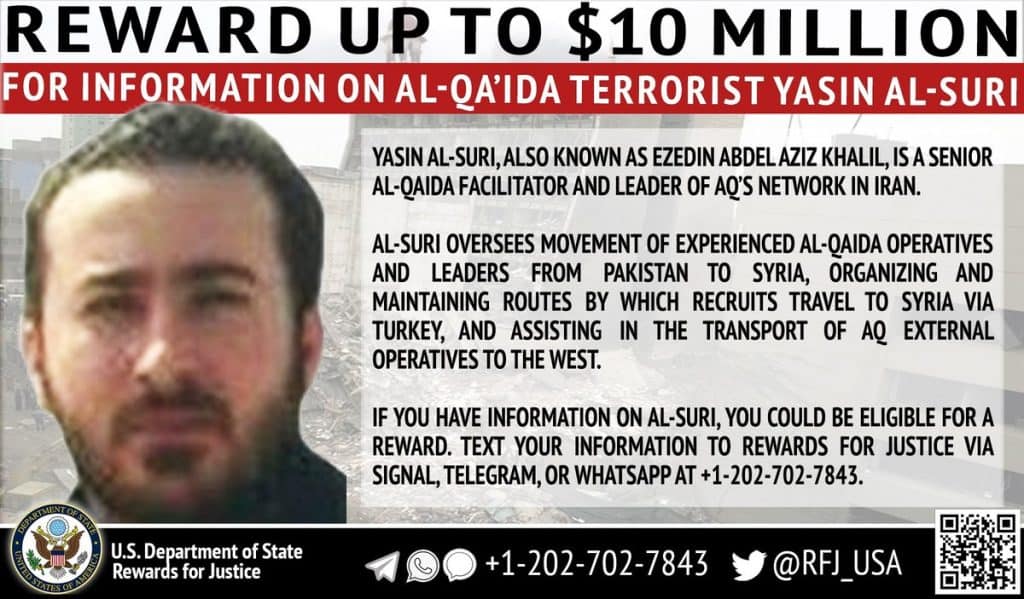
The U.S. State Department today revealed additional details concerning the senior al Qaeda leaders operating inside Iran. Five al Qaeda figures have been added to the U.S. government’s list of specially designated global terrorists. The most noteworthy of them is Muhammad Abbatay, more commonly known as ‘Abd al Rahman al Maghrebi.
Maghrebi, a native Moroccan, is the son-in-law al Qaeda’s global leader, Ayman al Zawahiri. Born on July 1, 1970, Maghrebi has served in a number of senior roles. The State Department describes him as the “longtime director” of As Sahab, al-Qaeda’s central media arm, as well as the “head” of the group’s “External Communications Office.” In that latter job, Maghrebi “coordinates activities with” al Qaeda’s “affiliates.” Maghrebi has also been al Qaeda’s “general manager in Afghanistan and Pakistan since 2012.”
In conjunction with today’s designation, a reward of up to $7 million for information on Maghrebi’s whereabouts was announced by the State Department’s Rewards for Justice program.
Pointing to files recovered during the May 2011 raid on Osama bin Laden’s compound, the State Department says that Maghrebi has been a “rising star” within al Qaeda “for many years.”
Indeed, Maghrebi is discussed in the correspondence between Atiyah Abd al-Rahman, who served as al Qaeda’s general manager before his death in 2011, and Osama bin Laden. In one memo, Atiyah mentioned that Maghrebi was already in “charge” of As Sahab. But Atiyah recommended Maghrebi for a possible promotion, writing that the Moroccan was a good candidate to become one of Atiyah’s deputies.
Maghrebi “has a fine intellect, and as far as I can judge, his faith is strong,” Atiyah wrote. “He [Maghrebi] has high morals, he can keep a secret, and he is patient. His ideology is prudent, and he has excellent awareness.”
Atiyah explained that Maghrebi is “good for command,” but some “senior members” of al-Qaeda (meaning “older shiekhs”) may not accept Maghrebi as a deputy general manager because he is “newer than them.” Atiyah advised bin Laden that this “problem” could be “solved” if bin laden issued an audio message announcing the appointment of Maghrebi. Atiyah said he would “check on this approach” and await bin Laden’s guidance.
Maghrebi eventually did take on other senior roles, as mentioned by the State Department. Atiyah was killed in a drone strike in northern Pakistan in August 2011. One month before, in July 2011, the U.S. Treasury Department designated Atiyah as a terrorist. Treasury stated that bin Laden had “appointed” Atiyah “to serve as al Qaeda’s emissary in Iran, a position which allowed him to travel in and out of Iran with the permission of Iranian officials.”
And now, according to the State Department, Maghrebi is located in Iran as well.
In addition to Maghrebi, the State Department designated a senior al Qaeda figure known as Sultan Yusuf Hasan al ‘Arif, but provided no information about his current role. Identifying information indicates that al ‘Arif is a Saudi national who was born in 1986. Al ‘Arif is also known as Qattal al ‘Abdali, Qital al-Najdi, and Abu Musab al-Saudi.
Three other al Qaeda-affiliated jihadists — Isma’il Fu’ad Rasul Ahmed, Fuad Ahmad Nuri Ali al-Shakhan, and Niamat Hama Rahim Hama Sharif — were designated as well. All three are Iraqis who were born in the 1970s. The are leaders of the al Qaeda Kurdish Battalions (AQKB), which was designated as a terrorist organization in 2012. [See FDD’s Long War Journal report, US adds Al Qaeda Kurdish Battalions to list of terror groups.]
The State Department also revealed that Yasin al-Suri, one of al Qaeda’s top facilitators, and Saif al Adel, one of Ayman al Zawahiri’s deputy emirs, are also still located inside Iran.

In mid-2018, a team of experts working for the United Nations Security Council revealed that al Adel and his comrade, Abdullah Ahmed Abdullah (a.k.a. Abu Muhammad Al-Masri), were playing prominent management roles within al Qaeda. Both were located in Iran. On Aug. 7, 2020, Abdullah was killed by Israeli assassins in a Tehran suburb. Abdullah was considered al Qaeda’s number two at the time — a role that al Adel may now fill.
Previous designations and other statements by Treasury and State Departments
The U.S. Treasury and State Departments have repeatedly pointed to the presence of al Qaeda leaders and networks inside Iran.
In 2008 and 2009, Treasury reported that several al Qaeda operatives were either living inside Iran, or working with other jihadists in the country.
Then, beginning in July 2011, both the Treasury and State Departments repeatedly targeted the Iran-based network with sanctions and terror designations, saying that the hub is operated as part of a formerly “secret deal” between the Iranian government and al Qaeda’s leadership. Both departments explained that al Qaeda’s “core facilitation pipeline” is in Iran.
Below is a brief timeline of designations and other official statements by the U.S. government.
June 2008: Treasury designated `Abd al-Rahman Muhammad Jaffar `Ali, an al Qaeda “financier and facilitator” based in Bahrain “who has provided significant funding to” al Qaeda. Among his other tasks, `Ali “facilitated the movement of money to a senior al Qaeda facilitator in Iran.”
Treasury also designated Adil Muhammad Mahmud Abd Al Khaliq, who served al Qaeda’s senior leaders and “provided financial, material, and logistical support to al Qaeda and the Libyan Islamic Fighting Group (LIFG).” Treasury explained that “[b]etween 2004 and 2007, Abd al Khaliq traveled to Iran five times on behalf of al Qaeda and the LIFG for his facilitation duties.” Abd al Khaliq “met with senior al Qaeda facilitators” during “each of these trips.” And during “this same timeframe,” Abd al Khaliq “provided material support to al Qaeda and the LIFG by equipping them with electrical parts used in explosives, laptop computers, jackets, GPS devices, and other equipment.” He also “arranged the transportation of fighters, money, and material to LIFG camps in Pakistan.”
Jan. 2009: Treasury designated four al Qaeda members in Iran, including Osama bin Laden’s son Saad, who was later killed after relocating to Pakistan. “It is important that Iran give a public accounting of how it is meeting its international obligations to constrain al Qaeda,” Stuart Levey, who was then Under Secretary for Terrorism and Financial Intelligence, said at the time.
July 2011: Treasury targeted Iran’s formerly “secret deal” with al Qaeda, designating six jihadists who were involved with al Qaeda’s network inside the country. One of them is known as Yasin al Suri, “a prominent Iran-based al Qaeda facilitator” who operates “under an agreement between al Qaeda and the Iranian government.” The agreement was negotiated with Atiyah Abd al Rahman’s permission. Atiyah was a top al Qaeda lieutenant who was killed in a US drone strike in mid-2011. As noted above, Atiyah was appointed by bin Laden to serve as al Qaeda’s “emissary in Iran.”

“Iran is the leading state sponsor of terrorism in the world today,” David S. Cohen, who was then Under Secretary for Terrorism and Financial Intelligence, said in a press release. “By exposing Iran’s secret deal with al Qaeda allowing it to funnel funds and operatives through its territory, we are illuminating yet another aspect of Iran’s unmatched support for terrorism,” Cohen emphasized.
Dec. 2011: The State Department announced a $10 million reward for Yasin al Suri, making him one of the most wanted terrorists on the planet. “Under an agreement between al Qaeda and the Government of Iran, Yasin al Suri has helped move money and recruits through Iran to al Qaeda leaders in neighboring countries in the region,” Robert Hartung, the State Department Assistant Director for Threat Investigations and Analysis, explained during a briefing.
Feb. 2012: The Treasury Department designated the Iranian Ministry of Intelligence and Security (MOIS) for a number of reasons, including the assistance it provided to al Qaeda and al Qaeda in Iraq. According to Treasury, the “MOIS has facilitated the movement of al Qaeda operatives in Iran and provided them with documents, identification cards, and passports.” In addition, the MOIS has “provided money and weapons to al Qaeda in Iraq (AQI)…and negotiated prisoner releases of AQI operatives.”
July 2012: In its Country Reports on Terrorism 2011, the State Department reported that “Iran remained unwilling to bring to justice senior AQ members it continued to detain, and refused to publicly identify those senior members in its custody.” Iran “also allowed AQ members to operate a core facilitation pipeline through Iranian territory, enabling AQ to carry funds and move facilitators and operatives to South Asia and elsewhere.”
October 2012: Treasury explained that Yasin al Suri had been temporarily sidelined as the chief of al Qaeda’s network in Iran. His replacement was Muhsin al Fadhli, a veteran Kuwaiti operative, who later relocated to Syria as part of al Qaeda’s “Khorasan Group” and was killed in an American airstrike. Treasury named Adel Radi Saqr al Wahabi al Harbi as one of Fadhli’s men inside Iran. Harbi also eventually relocated to Syria, where he served as the military commander of Jund al Aqsa, an al Qaeda front group, until meeting his own demise.
Treasury explained how the deal between the Iranian regime and al Qaeda works. “Under the terms of the agreement between al Qaeda and Iran,” Treasury reported, “al Qaeda must refrain from conducting any operations within Iranian territory and recruiting operatives inside Iran while keeping Iranian authorities informed of their activities.” As long as al Qaeda didn’t violate these terms, “the Government of Iran gave the Iran-based al Qaeda network freedom of operation and uninhibited ability to travel for extremists and their families.”
Treasury’s Cohen explained in a press release that the designation of Harbi “builds on our action from July 2011” and “further exposes al Qaeda’s critically important Iran-based funding and facilitation network.” Cohen added: “We will continue targeting this crucial source of al Qaeda’s funding and support, as well as highlight Iran’s ongoing complicity in this network’s operation.”
May 2013: In its Country Reports on Terrorism 2012, the State Department said that Iran “allowed AQ facilitators Muhsin al-Fadhli and Adel Radi Saqr al-Wahabi al-Harbi to operate a core facilitation pipeline through Iran, enabling AQ to move funds and fighters to South Asia and to Syria.” Fadhli “began working with the Iran-based AQ facilitation network in 2009,” was “later arrested by Iranian authorities,” but then released in 2011 so he could assume “leadership of the Iran-based AQ facilitation network.”
Jan. 2014: Treasury and State Department officials told Al Jazeera that Yasin al Suri was once again in charge of al Qaeda’s Iran-based network.
Feb. 2014: Treasury identified another Iran-based al Qaeda facilitator, Olimzhon Adkhamovich Sadikov, who is an Uzbek and part of the Islamic Jihad Union. Sadikov “provides logistical support and funding to al Qaeda’s Iran-based network,” according to Treasury.
Apr. 2014: In its Country Reports on Terrorism 2013, the State Department once again noted that the Iranian regime hosted al Qaeda’s “core facilitation pipeline” and “remained unwilling to bring to justice senior al Qaeda (AQ) members it continued to detain,” while also refusing “to publicly identify those senior members in its custody.”
Aug. 2014: Treasury designated a senior al Qaeda leader known as Sanafi al Nasr, who “served in early 2013 as chief of al Qaeda’s Iran-based extremist and financial facilitation network.” Nasr relocated to Syria in 2013 as part of al Qaeda’s “Khorasan Group” and was killed in an American airstrike in 2015.
June 2016: The State Department’s Country Reports on Terrorism 2015 is released. “Iran remained unwilling to bring to justice senior al-Qa’ida (AQ) members it continued to detain and refused to publicly identify the members in its custody,” the report read. State added: “Iran previously allowed AQ facilitators to operate a core facilitation pipeline through Iran since at least 2009, enabling AQ to move funds and fighters to South Asia and Syria.” The implication of the language (“previously allowed”), which was included in the 2014 report as well, was that al Qaeda no longer operated its facilitation network inside Iran. However, al Qaeda did in fact continue to operate its pipeline inside Iran. Country Reports on Terrorism 2016 removed the phrase “previously allowed” from its summary.
July 2016: The US Treasury Department designated three senior al Qaeda figures “located in Iran”: Faisal Jassim Mohammed Al Amri Al Khalidi, Yisra Muhammad Ibrahim Bayumi, and Abu Bakr Muhammad Muhammad Ghumayn. Treasury explained that it took the action to “disrupt the operations, fundraising, and support networks that help al Qaeda move money and operatives from South Asia and across the Middle East.”
Faisal Jassim Mohammed Al Amri Al Khalidi (a.k.a. Abu Hamza al Khalidi), has served as al Qaeda’s “Military Commission Chief” — meaning he was one of the most important figures in the group’s international network. Al Khalidi was identified in Osama bin Laden’s files as part of a “new generation” of leaders al Qaeda groomed to replace their fallen comrades.
July 2017: The State Department released its Country Reports on Terrorism 2016. “Iran remained unwilling to bring to justice senior al-Qa’ida (AQ) members it continued to detain and has refused to publicly identify the members in its custody,” the report reads. “Since at least 2009, Iran has allowed AQ facilitators to operate a core facilitation pipeline through the country, enabling AQ to move funds and fighters to South Asia and Syria.”
Sept. 2018: The State Department’s Country Reports on Terrorism 2017 repeated the language regarding al Qaeda’s network inside Iran.
*Note: The spelling of al Qaeda was changed in some quotes to make it consistent throughout.







